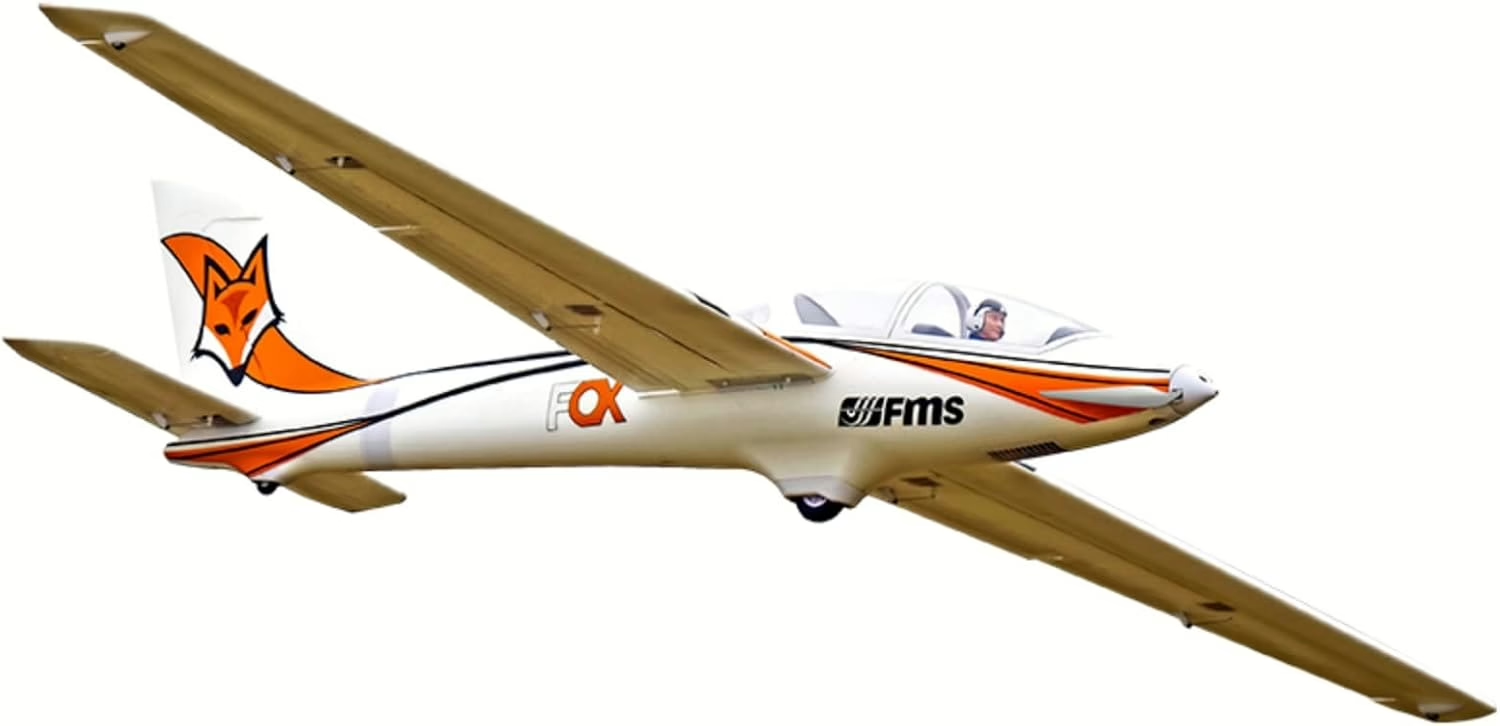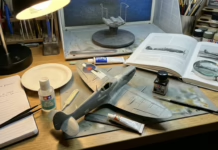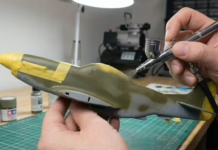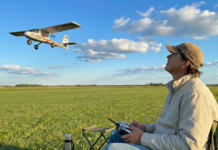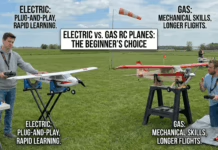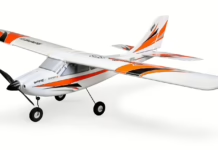Ready to move beyond your trainer? We’ve flight-tested the top intermediate RC planes of 2025 to find models that combine aerobatic capability, durability, and smart electronics. From warbirds to 3D sport planes, these are the aircraft that will develop your skills without emptying your wallet.
Moving from a high-wing trainer to an intermediate RC plane represents one of the most rewarding transitions in the hobby. You’re shifting from aircraft designed to fight the wind and self-correct to machines that respond precisely to your inputs and hold whatever attitude you command. It’s where you stop managing the plane’s position and start actually flying.
The 2025 intermediate market offers sophisticated options built from high-density EPO foam with integrated stabilization systems and efficient brushless power. This roundup analyzes the current landscape to help U.S. pilots choose their next aircraft based on real-world performance, not just marketing claims.
Understanding the Intermediate Category
An intermediate RC plane sits between forgiving trainers and demanding expert aircraft. These models typically feature semi-symmetrical or symmetrical airfoils that enable smooth inverted flight and axial rolls. Unlike trainers with flat-bottom airfoils optimized for maximum lift, intermediate planes require active throttle and elevator management—teaching you the critical relationship between pitch and power.
Key characteristics that define intermediate aircraft include:
- Retractable Landing Gear: Reduces drag for higher speeds and better vertical performance, while teaching proper landing gear management
- Functional Flaps: Allow steeper approaches without increasing airspeed—essential for landing in smaller fields
- Reduced Dihedral: Flatter wings eliminate the self-leveling tendency, providing the locked-in feel needed for precision aerobatics
Modern stabilization technology like AS3X has changed the learning curve significantly. These gyro-based systems don’t fly the plane for you—they dampen wind gusts and turbulence so you can focus on stick inputs. It’s a safety net that lets intermediate pilots tackle more capable airframes without the constant battle against weather.
What Makes a Plane “Intermediate”?
Beyond the high-wing trainer but short of giant-scale models, intermediate aircraft teach you to fly the wing rather than just manage position. Higher wing loadings mean faster stall speeds and more critical energy management during landing. The mechanical complexity mirrors full-scale aviation—retracts that must be properly sequenced, flaps that change wing characteristics, and reduced stability that demands constant pilot input.
These aircraft excel as workhorses. They’re durable enough for weekly flying, capable enough to teach the full aerobatic repertoire, and generally affordable enough that a crash is recoverable rather than catastrophic.
Best RC Planes for Intermediate Compared at a Glance
This comparison synthesizes flight performance, build quality, and value. Star ratings reflect weighted averages with heavy emphasis on how well each aircraft rewards developing skills.
| Model | Best For | Flight Performance | Power System | Durability | Parts Support | Value |
|---|---|---|---|---|---|---|
| E-flite T-28 Trojan 1.2m | Overall Performance | ★★★★★ | ★★★★★ | ★★★★★ | ★★★★★ | ★★★★☆ |
| Tower Hobbies Cessna 400 | Value | ★★★★☆ | ★★★★☆ | ★★★★☆ | ★★★★☆ | ★★★★★ |
| VolantexRC Saber 920 | Budget/Durability | ★★★☆☆ | ★★★☆☆ | ★★★☆☆ | ★★★☆☆ | ★★★★★ |
| Dynam Hawksky V2 | Long Flight Times | ★★★★☆ | ★★★☆☆ | ★★★★☆ | ★★★☆☆ | ★★★★☆ |
| FMS 3000mm Fox | Giant Scale Soaring | ★★★★★ | ★★★★☆ | ★★★★☆ | ★★★★☆ | ★★★☆☆ |
| ZOHD Dart XL Extreme | FPV Flying | ★★★★☆ | ★★★★★ | ★★★★★ | ★★★☆☆ | ★★★★☆ |
| ZOHD Dart250G | Sub-250g Performance | ★★★★☆ | ★★★★☆ | ★★★☆☆ | ★★★☆☆ | ★★★★★ |
| RCSHOBBY Sport Cub 500 | Backyard Flying | ★★★☆☆ | ★★★☆☆ | ★★★☆☆ | ★★★☆☆ | ★★★★☆ |
| FMS 1220mm Ranger | STOL/All-Terrain | ★★★★☆ | ★★★★☆ | ★★★★★ | ★★★★☆ | ★★★★☆ |
| RCG Racing ZY-320 Raptor | Compact Speed | ★★★☆☆ | ★★★★☆ | ★★★☆☆ | ★★★☆☆ | ★★★★☆ |
What Is the Best RC Plane for Intermediate?
The best intermediate aircraft builds confidence while expanding capabilities. It needs enough power to recover from mistakes, stability to handle challenging conditions, and durability to survive the learning process. When evaluating the entire market through this lens, one model consistently delivers.
Best Overall: E-flite T-28 Trojan 1.2m BNF Basic
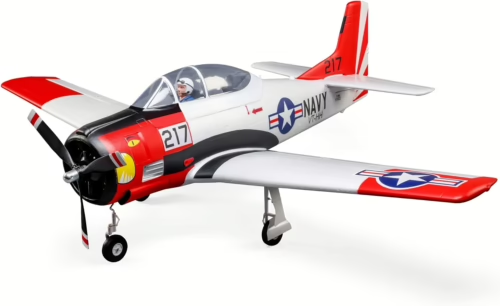
The E-flite T-28 Trojan 1.2m BNF Basic stands out as the definitive intermediate aircraft for 2025. The full-scale North American T-28 Trojan was designed in the 1950s to transition pilots from trainers to jets—and this RC version serves the same purpose perfectly.
Quick Overview
Built from durable Z-Foam with functional flaps and electric retractable landing gear, the T-28 combines scale appearance with sport-plane performance. The tricycle landing gear configuration provides stable ground handling that eliminates the anxiety of takeoff and landing, while the power system offers enough authority for confident aerobatics.
Who should buy this: Pilots who’ve mastered high-wing trainers and want warbird aesthetics without tail-dragger ground handling challenges.
Why you’ll love it: Exceptional visibility with bright yellow livery, rock-solid stability, and the satisfaction of flying a historically accurate trainer that performs beautifully.
Key Features
- AS3X and SAFE Select: 3-axis gyro smooths turbulence while optional SAFE mode limits pitch and bank for panic recovery
- Functional Flaps and Retracts: High-torque servos drive flaps for short landings, electric retracts clean up the airframe for speed
- 15-Size Brushless Motor: Compatible with 3S (docile cruiser) or 4S (high-performance) LiPo batteries
- Tricycle Landing Gear: Steerable nose wheel and wide stance prevent ground loops and prop strikes
- Easy Battery Access: Large canopy hatch enables quick battery swaps without wing removal
Technical Specifications
- Wingspan: 1225mm (48.2 inches)
- Length: 985mm (38.8 inches)
- Flying Weight: 1470g (52 oz)
- Motor: 850Kv brushless outrunner (15-size)
- ESC: 40A brushless (3S/4S compatible)
- Propeller: 12×8 3-blade scale prop
- Material: Z-Foam (EPO)
- Radio: Requires 6+ channel DSMX/DSM2 transmitter
Build Quality
The T-28 showcases E-flite’s foam molding expertise. Dense Z-Foam with smooth finish resists wear, molded panel lines add realism, and the carbon fiber wing spar prevents flex during high-G maneuvers. The retractable landing gear units mount securely, though hard landings can loosen them—a common maintenance consideration. Pre-installed wiring is clean and organized.
Pros and Cons
Pros:
- Wide flight envelope from slow to fast
- Excellent U.S. parts support through Horizon Hobby
- 3S/4S battery compatibility (training to performance)
- Durable foam and protective tricycle gear
Cons:
- Retract servos can strip in tall grass or rough terrain
- Battery tray fits larger 4S packs snugly
- Premium pricing compared to imports
Flight Experience
Takeoff is straightforward—advance throttle and the steerable nose wheel tracks straight with minimal rudder. Rotation is smooth, and the climb is authoritative. In flight, the T-28 stays locked on its path. Loops are round and predictable. Stalls are gentle with a predictable nose drop rather than wing snapping. Landing with flaps deployed slows the plane to a crawl for professional-looking mains-first touchdowns.
Price and Availability
Typically retails between $279.99 and $329.99 for the BNF Basic version. Widely available through Horizon Hobby, Amazon, and U.S. hobby shops.
Best RC Planes for Intermediate – In-Depth Reviews
Tower Hobbies Cessna 400 1.1m PNP – Best Value
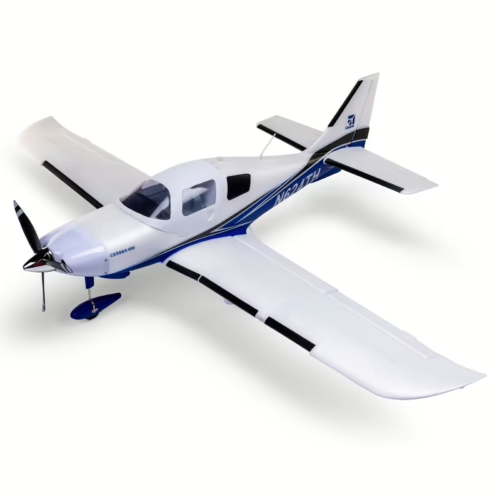
Quick Overview
The Tower Hobbies Cessna 400 Corvalis replicates the high-performance composite aircraft with impressive fidelity. Unlike common Cessna trainers, the 400 is built for speed—and this model delivers sport-plane performance at a budget-friendly price, often under $170. The high-wing configuration combined with minimal dihedral creates a plane that requires active speed management rather than self-leveling.
Who should buy this: Budget-conscious pilots who appreciate civilian aviation and want a sleek performer.
Why you’ll love it: The aerodynamic efficiency produces a satisfying whoosh during high-speed passes, and the clean lines look fantastic on the runway.
Key Features
- Scale Fidelity: Molded panel lines, wheel pants, and spinner accurately capture the Corvalis design
- Steerable Nose Wheel: Tricycle gear simplifies ground handling
- Flap Ready: Wing cutouts accept servos for functional flaps (excellent first modification project)
- Brushless Power: Outrunner motor provides spirited performance and large loops
Technical Specifications
- Wingspan: 1100mm (43.3 inches)
- Length: Approximately 1100mm
- Weight: 38-40 oz ready to fly
- Motor: Brushless outrunner
- Propeller: Scale 3-blade prop
- Recommended Battery: 3S 2200mAh LiPo
Build Quality
Constructed from EPO foam with smooth surface finish mimicking the composite full-scale aircraft. High-quality decal application and robust wire landing gear enclosed in aerodynamic wheel pants. Wing attachment uses bolts for structural rigidity. Note that wheel pants can clog with grass—many pilots remove them for rough field operations.
Pros and Cons
Pros:
- Outstanding performance per dollar
- Sleek, scale appearance
- Faster than typical high-wing models
- Fixed gear simplicity
Cons:
- Wheel pants unsuitable for tall grass
- PNP format requires separate receiver purchase
- Flaps not functional out of box
Flight Experience
The Cessna 400 flies clean and fast. It accelerates quickly and carries energy through turns, teaching proper throttle management—you can’t just chop power and expect it to stop. Landing requires a flatter approach than draggy warbirds. It’s a graceful, swift flyer rewarding smooth inputs.
Price and Availability
Available through Tower Hobbies and Horizon Hobby, typically $160-$180.
VolantexRC Saber 920 – Best Budget-Friendly Option
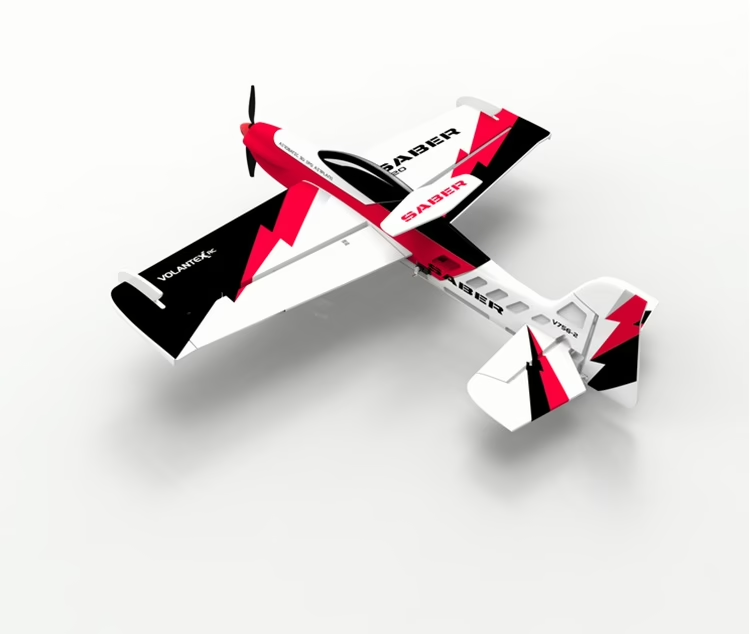
Quick Overview
The VolantexRC Saber 920 is a 3D trainer designed for advanced aerobatics like hovering and knife-edge flight. Its hybrid construction—blow-molded plastic fuselage with EPO foam wings—makes it nearly indestructible. The plastic fuselage acts like a flexible bottle, surviving impacts that would shatter foam construction.
Who should buy this: Pilots wanting to learn 3D aerobatics without expensive aircraft anxiety.
Why you’ll love it: The crash-resistant design encourages aggressive flying and skill development.
Key Features
- Plastic Unibody Fuselage: Blow-molded ABS plastic resists impact and cracking
- Mid-Wing Configuration: Thrust line aligned with wing for neutral handling and axial rolls
- Oversized Control Surfaces: Large ailerons and elevator provide low-speed authority
- Plug-and-Play: Includes motor and servos, needs only receiver and battery
Technical Specifications
- Wingspan: 920mm (36.2 inches)
- Length: 875mm
- Flying Weight: Approximately 1100g
- Motor: 4023/1050KV brushless
- ESC: 30A brushless
- Battery: 3S 2200mAh LiPo
Build Quality
Utilitarian design prioritizes function over appearance. Carbon-reinforced wings prevent snapping during high-G pullouts. Aluminum landing gear designed to bend rather than tear out fuselage mounts—smart engineering for a trainer. Stock analog servos are functional but common upgrade candidates.
Pros and Cons
Pros:
- Virtually indestructible plastic fuselage
- Very affordable
- Capable of hovering and knife-edge
- Standard electronics
Cons:
- Toy-like appearance compared to scale models
- Decals peel over time
- Basic servo quality
Flight Experience
The Saber responds instantly to inputs—snappy enough that beginners may find it twitchy. Using exponential settings softens center stick response. Once mastered, it tumbles through the sky beautifully, teaching proper rudder coordination often neglected in basic training.
Price and Availability
Approximately $120-$150 via VolantexRC, Banggood, and Amazon.
Dynam Hawksky V2 – Best for Long Flight Times
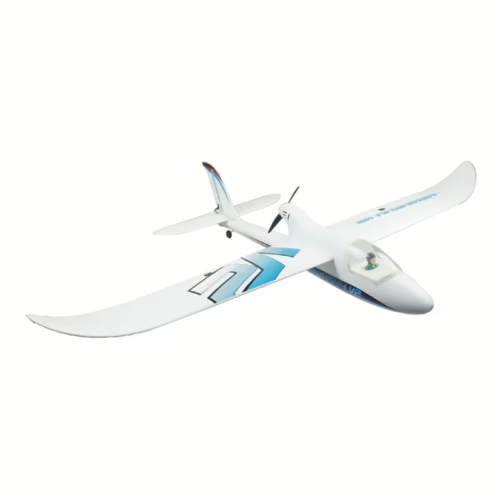
Quick Overview
The Dynam Hawksky V2 is a powered glider with pusher-prop configuration—motor mounted above the wing facing backward. This completely protects the propeller and motor from nose-first impacts, making it ideal for low-altitude practice. The glider-style wings provide low wing loading and slow stall speed, giving pilots extra thinking time during maneuvers.
Who should buy this: Pilots wanting relaxing, long-duration flights and a forgiving platform for practicing orientation.
Why you’ll love it: Flight times exceeding 20 minutes with standard batteries by mixing powered climbs with gliding.
Key Features
- Pusher Configuration: Saves propellers and motor shafts from damage
- EPO Construction: Durable and easily repaired with CA glue
- High Aspect Ratio Wing: Efficient gliding for catching thermals
- 4-Channel Control: Full aileron, elevator, rudder, throttle for complete aerobatic capability
Technical Specifications
- Wingspan: 1370mm (53.9 inches)
- Length: 950mm
- Motor: BM2810mm-1900KV brushless
- ESC: 30A with BEC
- Battery: 3S 2200mAh LiPo
Build Quality
Dynam models offer solid construction with occasional minor fit issues requiring trimming or adjustment during assembly. The canopy latch is a known weak point often upgraded with tape or magnets. Overall airframe structural integrity is excellent for the price point.
Pros and Cons
Pros:
- Propeller protected from landing damage
- Dual-purpose glider and sport plane
- Large wingspan aids visibility
- Very affordable
Cons:
- Minor assembly adjustments often needed
- Not a high-speed performer
- Budget-grade servos
Flight Experience
The Hawksky is relaxing to fly. It climbs with authority, then you can cut power and hunt for lift. When you want excitement, dive it for loops and rolls. If you get disoriented, releasing the sticks usually results in a gentle glide. Perfect for building flight time without stress.
Price and Availability
Typically $130-$150 through DynamRC distributors and hobby retailers.
FMS 3000mm Fox Aerobatic EP Glider – Best for Aerobatic Gliding
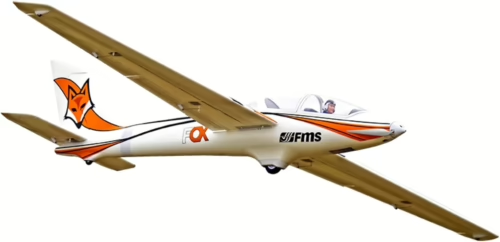
Quick Overview
The FMS Fox is a giant-scale replica of the MDM-1 Fox, a Polish aerobatic glider. With a 3-meter (nearly 10-foot) wingspan, it flies with the momentum and presence of a much heavier aircraft. It democratizes giant-scale flight through molded foam construction with carbon and aluminum reinforcement, offering screw-together assembly that fits in standard vehicles.
Who should buy this: Pilots wanting giant glider presence and high-energy aerobatic capability.
Why you’ll love it: The aerodynamic whistle of a 3-meter glider diving at speed.
Key Features
- 3000mm Wingspan: Provides immense lift and impressive visual presence
- Quick-Release Wings: Tool-free assembly enables fast field setup
- Functional Flaps: Essential for slowing the large airframe for landing
- High-Voltage Power: 6S LiPo provides potent climb performance
Technical Specifications
- Wingspan: 3000mm (118 inches)
- Length: 1873mm
- Flying Weight: Approximately 4.7kg (10.4 lbs)
- Motor: 4258-KV460 brushless
- ESC: 70A brushless
- Battery: 6S 5000mAh LiPo
Build Quality
FMS’s flagship glider features extremely dense foam reinforced with an aluminum and carbon fiber skeleton, preventing wing flex. Large fuselage provides ample cooling. True-to-glider single centerline wheel landing gear. Sparse but functional cockpit detail.
Pros and Cons
Pros:
- True giant-scale experience
- Unlimited aerobatic potential with excellent energy retention
- Innovative quick-release system
- Strong climb on 6S
Cons:
- Large transport requirements (2-meter fuselage)
- Requires a spacious flying field
- Significant investment in airframe and batteries
Flight Experience
The Fox changes your flying perspective. It doesn’t react instantly—it flows through maneuvers. Everything requires planning ahead. The loop is massive. Landing demands precise energy management using flaps and throttle to control a 10-pound glider that wants to keep flying. Teaches energy management better than any other intermediate plane.
Price and Availability
Approximately $450-$550 via FMS and major retailers.
ZOHD Dart XL Extreme – Best for FPV Flying
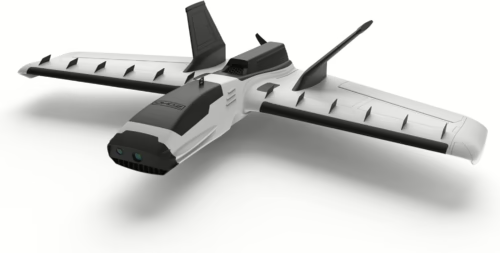
Quick Overview
The ZOHD Dart XL Extreme is a forward-swept flying wing designed specifically for First Person View flight. Unlike traditional delta wings prone to tip-stalls, the forward-swept design with wingtip vertical stabilizers provides exceptional stability. Purpose-built with dedicated bays for cameras, video transmitters, and flight controllers.
Who should buy this: Pilots interested in long-range cruising or video goggle flying who want a stable platform.
Why you’ll love it: Stable enough to carry a GoPro for cinematic footage.
Key Features
- Forward-Swept Wing: Increases lift at low speeds and improves handling
- Vortex Generators: Molded leading edge improves airflow
- Detachable Wings: Breaks down for backpack transport
- NACA Air Inlets: Efficient cooling for electronics
Technical Specifications
- Wingspan: 1000mm (39.37 inches)
- Motor: 2216-1300KV
- ESC: 30A with 5V 3A BEC
- Battery: 4S 3300mAh LiPo
- Material: BEPP (Biodegradable EPP)
Build Quality
Molded from durable BEPP foam, resisting compression. Thoughtful layout includes a plywood electronics floor. Sturdy motor mount. Foam hinges are generally reliable, though some users reinforce with tape.
Pros and Cons
Pros:
- Excellent FPV tracking stability
- Aggressive, futuristic appearance
- Well-designed electronics bays
- Durable BEPP foam
Cons:
- Hand-launching rear-prop wings requires care
- Some yaw waggle in turbulence
- Requires FPV gear knowledge
Flight Experience
The Dart XL flies on rails. Forward sweep makes stalling difficult. Main learning curve involves the launch (firm toss with throttle) and belly landing. Once airborne, it’s a relaxing long-range cruiser.
Price and Availability
Approximately $160-$200 via ZOHD, Banggood, and Amazon.
ZOHD Dart250G – Best for Hands-down Performance
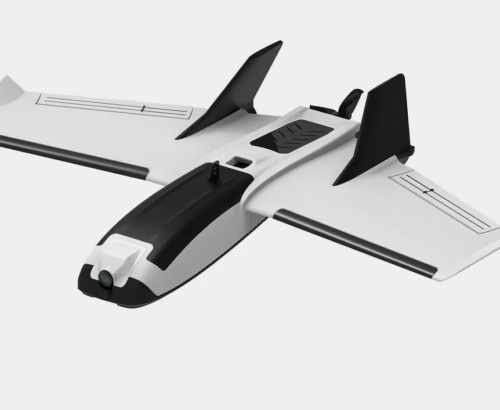
Quick Overview
The ZOHD Dart250G packs high-speed performance into the sub-250-gram weight class, which in many U.S. jurisdictions faces fewer regulations. Despite its size, it’s not a toy—high-KV brushless motors enable speeds over 60mph in a legally advantageous package.
Who should buy this: Pilots wanting a grab-and-go plane for smaller parks without regulatory concerns.
Why you’ll love it: Fits in a small box, uses inexpensive batteries, delivers adrenaline.
Key Features
- Sub-250g Weight: Regulatory advantages (verify local laws)
- Forward-Swept Wing: Retains XL’s stable characteristics
- FPV Camera Compatible: Nose molded for micro cameras
Technical Specifications
- Wingspan: 570mm
- Motor: 1406-2600KV
- Battery: 2S 900mAh or 3S 650mAh
Build Quality
Detailed EPP molding with carbon reinforcement despite small size. Micro components require careful handling for repairs.
Pros and Cons
Pros:
- Typically under 250g limit
- High power-to-weight ratio
- Backpack portable
Cons:
- Wind sensitive
- Hard to see at distance
- Delicate micro servos
Flight Experience
The Dart250G is frenetic and responsive, requiring pilots to stay ahead of the plane. Excellent for reflex training. More exciting than relaxing, but thrilling per flight minute.
Price and Availability
Approximately $100 PNP. Widely available online.
RCSHOBBY Sport Cub 500 4ch – Best for Agility and Style
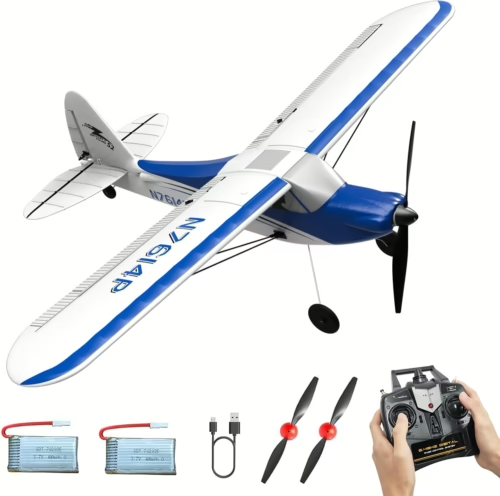
Quick Overview
The Sport Cub 500 is a micro-scale Piper Cub with 4-channel control enabling true aerobatics. The 6-axis gyro system stabilizes this 500mm plane enough for light wind flying. One-key aerobatic feature performs automatic loops, though most pilots prefer manual control.
Who should buy this: Pilots with limited space or wanting a durable trainer for family flying.
Why you’ll love it: No driving to the field required—fly in your yard.
Key Features
- Prop Saver System: Pop-off prop protects motor in crashes
- 6-Axis Gyro: Switchable stability modes (Beginner, Midi, Expert)
- EPP Construction: Highly crash-resistant foam
Technical Specifications
- Wingspan: 500mm
- Motor: 10mm coreless brushed
- Battery: 1S 3.7V 360mAh
Build Quality
Flexible EPP foam absorbs impacts well. Plastic gearbox can strip over time. Integrated electronics board simplifies replacement.
Pros and Cons
Pros:
- Minimal space requirements
- Survives crashes well
- Very affordable
Cons:
- Brushed motor wears out
- Unflyable in winds over 5-7mph
- Basic controller
Flight Experience
A fun diversion for maintaining skills. Doesn’t match the T-28’s authority but provides convenient flying practice. Gyro assistance necessary at this scale.
Price and Availability
Approximately $80-$100 on Amazon.
FMS 1220mm Ranger – Best for All-Terrain Operations
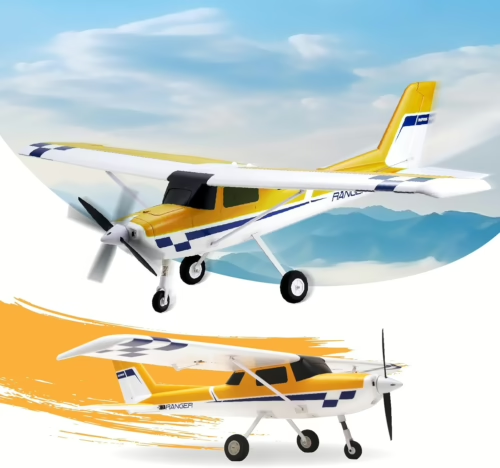
Quick Overview
The FMS Ranger 1220mm is a STOL aircraft designed for operations where others can’t go—gravel, tall grass, or water with included floats. Functions as an intermediate trainer for bush-plane flying.
Who should buy this: Pilots flying rough fields or wanting to try float flying.
Why you’ll love it: Versatile enough to swap from wheels to floats in minutes.
Key Features
- Reflex Gyro: FMS proprietary stability system
- Floats Included: Complete with water rudders for lake operations
- High-Lift Wing: Designed for slow flight and heavy loads
Technical Specifications
- Wingspan: 1220mm
- Motor: 3136-1200KV
- ESC: 20A
- Battery: 3S 2200mAh
Build Quality
High-quality EPO with durable plastic cowl. Pre-installed LED lighting system for low-light flying. Tool-free screw-together assembly.
Pros and Cons
Pros:
- Water, snow, and grass capable
- Very stable and forgiving
- Floats included
Cons:
- Slower and less efficient
- Tight battery compartment for some packs
Flight Experience
The Ranger is a predictable workhorse. Water takeoffs teach new skills—managing the plane through “step” and using water rudders. A relaxing, capable adventure platform.
Price and Availability
Approximately $200 via FMS and Amazon.
ZY-320 – Best Compact High-Speed Flyer
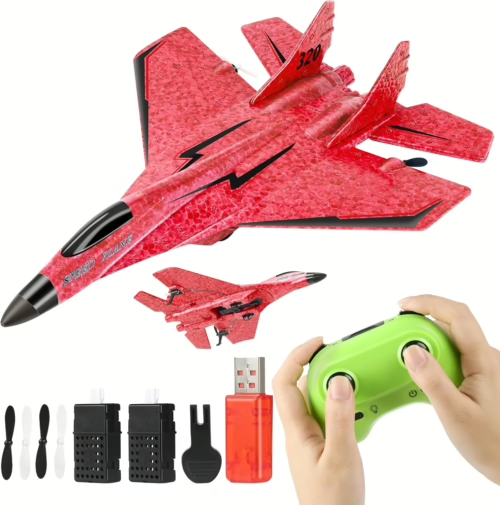
Quick Overview
The ZY-320 is a small, hand-launch plane blending fighter jet and glider styling. Designed for high-speed cruising in compact areas with distinctive stealth-drone appearance.
Who should buy this: Pilots wanting a unique, compact airframe.
Why you’ll love it: Distinctive looks and portability.
Key Features
- Twin Vertical Stabilizers: Aggressive styling
- EPP Material: Soft crash-resistant foam
- 2.4GHz Control: Standard interference-free operation
Technical Specifications
- Wingspan: 320mm
- Range: Approximately 150m
- Flight Time: 12-15 minutes
Build Quality
Basic construction on the toy end of hobby-grade spectrum. Soft, durable foam. Simple electronics. Good value for the price.
Pros and Cons
Pros:
- Unique design
- Very durable
- Affordable
Cons:
- Less precise control than larger models
- Wind sensitive
Flight Experience
A park jet for casual flying. Toss it, zoom around, belly land. Great for low-stakes fun with friends.
Price and Availability
Approximately $60-$80 on Amazon.
What to Look for in a Quality Intermediate RC Plane
Selection Criteria
Choosing these category champions required rigorous evaluation based on intermediate pilot needs:
- Flight Characteristics: Neutral stability that holds bank angles and teaches energy management. Predictable stall behavior with gentle nose drops rather than violent wing drops.
- Power System: Brushless motors only—they’re efficient, powerful, and virtually maintenance-free. Power-to-weight ratios exceeding 0.8:1 for strong climbs and recovery capability.
- Construction Quality: EPO foam preferred over EPS for density, finish, and durability. Bolt-together designs superior to glued assemblies for maintenance.
- Parts Availability: Critical for intermediate pilots who will crash. Brands like E-flite, FMS, and Tower Hobbies maintain robust U.S. supply chains.
- Value: Not just purchase price, but total cost of ownership including durability and repair costs.
How to Choose Your Intermediate Plane
Assess Your Skills: Can you consistently land your trainer on centerline? If you still rely on panic buttons or crash regularly, stick with the Dynam Hawksky or FMS Ranger. If you’re bored flying circles, you’re ready for the T-28 or Cessna 400.
Evaluate Your Field: Paved runways suit the T-28 and Cessna 400. Rough fields need the belly-landing Volantex Saber or big-wheeled FMS Ranger. Small parks limit you to the Sport Cub 500 or Dart250G.
Define Your Goals: Want scale realism? Choose the T-28. Prefer 3D aerobatics? Get the Saber. Interested in FPV? The Dart XL fits perfectly. Align the aircraft with your aspirations.
Flying Your Intermediate Plane
Essential Tips
Center of Gravity is Critical: Tail-heavy intermediate planes become uncontrollable with pitch oscillations. Always verify CG per the manual before each flight with battery installed.
Master Coordinated Turns: Intermediate planes need rudder input with aileron turns to prevent adverse yaw and maintain efficiency. The T-28 teaches this beautifully.
Manage Energy: These planes don’t float indefinitely. Maintain some throttle until over the runway threshold. Don’t chop power at altitude expecting to glide in.
Use Dual Rates: Set low rates (70% throw) with 30% exponential for smoother control around center stick positions.
Final Thoughts
The 2025 intermediate RC plane market offers excellent options across all budgets and flying styles. Affordable brushless power, high-quality foam molding, and stabilization systems have made high-performance flight more accessible than ever.
The E-flite T-28 Trojan 1.2m BNF Basic remains our top recommendation—it’s the industry benchmark combining warbird looks, sport aerobatics, and forgiving handling. For budget-conscious pilots, the Tower Hobbies Cessna 400 delivers 90% of the performance at 60% of the cost.
Choose the aircraft that excites you, respect the physics, and enjoy the journey to becoming a better pilot.
FAQs
Q: Can I use my trainer’s transmitter with these planes?
A: Most basic RTF trainers include non-programmable transmitters. Intermediate planes (PNP or BNF) require programmable computer radios (6+ channels) supporting dual rates, exponential, and flap mixing. Investing in a quality radio like Spektrum NX series or Radiomaster is essential.
Q: Do I need FAA registration?
A: In the U.S., all RC aircraft over 250 grams (0.55 lbs) require FAA registration. You must also pass the TRUST recreational UAS safety test. Most planes in this roundup exceed 250g. The ZOHD Dart250G and Sport Cub 500 typically fall under the limit. Remote ID rules now apply to most aircraft over 250g unless flown in FAA-Recognized Identification Areas (FRIA).
Q: What’s the difference between EPO and EPP foam?
A: EPO (Expanded Polyolefin) is dense, smooth, and stiff—excellent for detail and aerodynamics. Used on the T-28 and Cessna. Breaks cleanly for easy gluing. EPP (Expanded Polypropylene) is soft and flexible—bounces in crashes but less aerodynamically efficient. Used on ZOHD wings and Sport Cub.
Q: Why do I need a brushless motor?
A: Brushless motors are significantly more efficient and powerful than brushed motors. They have no wearing brushes, meaning they last essentially forever if not overheated. They provide the thrust-to-weight ratio needed for vertical aerobatics and confident flying.

Key Takeaways
- The E-flite T-28 Trojan 1.2m leads the intermediate category with AS3X stability, tricycle gear forgiveness, and excellent warbird performance at a reasonable price.
- Intermediate flying means neutral stability—these aircraft follow your commands precisely without self-correcting, demanding active energy management and pilot input.
- The 2025 market offers specialized options for every progression path, whether you prioritize value (Tower Cessna 400), 3D capability (Volantex Saber), or giant-scale soaring (FMS Fox).
- Most intermediate aircraft require FAA registration as they exceed the 250g limit and must comply with Remote ID regulations when operating in the U.S.
- Modern stabilization technology like AS3X enhances rather than replaces piloting skill, expanding the flight envelope in challenging conditions.



